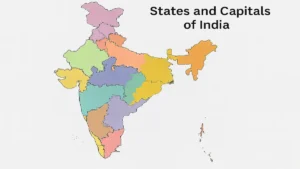Fitch Retains India’s ‘BBB-‘ Rating with Stable Outlook as Growth Potential Fights High Deficit Concerns:
Fitch Ratings has affirmed India’s long-term foreign-currency issuer default rating (IDR) at ‘BBB-‘ with a stable outlook. The rating agency cited India’s robust growth outlook and resilient external finances as key factors in supporting its decision, despite concerns over weak public finances and lagging structural indicators.
Buy Prime Test Series for all Banking, SSC, Insurance & other exams
Robust Growth Amid Headwinds:
Fitch forecast India to be one of the fastest-growing Fitch-rated sovereigns globally at 6% in the fiscal year ending March 2024 (FY24), supported by resilient investment prospects. However, headwinds from elevated inflation, high interest rates, and subdued global demand, along with fading pandemic-induced pent-up demand, will slow growth from our FY23 estimate of 7.0% before rebounding to 6.7% by FY25.
Robust Medium-Term Outlook:
Strong growth potential is a key supporting factor for India’s sovereign rating. The private sector appears poised for stronger investment growth following the improvement of corporate and bank balance sheets in the past few years, supported by the government’s infrastructure drive. However, risks remain given low labour force participation rates and an uneven reform implementation record.
Improving Financial Sector:
Sustained improvements in asset quality and profitability have led to a strengthening of bank balance sheets on the back of the economic recovery. This has created headroom to absorb risks as pandemic-related forbearance measures continue to unwind in FY24. Banks appear well-positioned to support sustained credit growth if capitalisation is well-managed.
Modest Deficit Reduction:
Fitch expects the general government deficit (excluding divestments) to narrow to a still-high 8.8% of GDP in FY24 (2023 BBB median: 3.6%) from 9.2% in FY23. The central government (CG) is expected to meet its budget’s planned reduction in the CG deficit to 5.9% of GDP in FY24 from 6.4% in FY23. Aggregate state deficits are forecast to rise slightly to 2.8% of GDP in FY24 from our 2.7% estimate in FY23, as they also raise capex.
Moderating Inflation:
Fitch forecasted headline inflation to decline but remain near the upper end of the Reserve Bank of India’s 2%-6% target band, averaging 5.8% in FY24 from 6.7% last year. Core inflation pressure appears to be abating, falling to 5.7% in March, its lowest since July 2021.
India’s Large Domestic Market:
India’s large domestic market makes it an attractive destination for foreign firms. However, it is unclear whether India will be able to realise sufficient reforms to allow the economy to benefit substantially from opportunities offered by the deeper integration in global manufacturing supply chains, including China+1 corporate strategies that encourage diversification in investment destinations. Service sector exports, however, are likely to remain a bright spot.
India Faces Fiscal Challenges as it Targets Consolidation:
The Indian government’s recent medium-term fiscal guidance retains its deficit target of 4.5% of GDP by FY26. However, the lack of details on how this target would be reached, combined with the need for accelerated consolidation, makes it challenging to achieve. To meet this target, the government would need to trim expenditure significantly in the coming years.
India’s High Public Debt Burden:
India’s general government debt is estimated to be 82.8% of GDP in FY23, much higher than the ‘BBB’ median of 55.4%. While there has been some consolidation, we forecast that debt will remain stable at around 83% of GDP in FY28. This lack of sustained debt reduction increases the risk to the rating, especially if India faces an economic or fiscal shock in the future.
High Government Interest Payment/Revenue Ratio::
India’s high government interest payment/revenue ratio of around 27% in FY23 is a growing structural fiscal weakness. The ‘BBB’ median for this ratio is only 7%. This means that a large portion of government revenue is being used to pay off interest on its debt, leaving less room for essential expenditures.
Current Account Deficit Narrowing:
They have brought down the estimate of India’s FY23 current account deficit to 2.3% of GDP, down from 3.3% in our December review. We expect a further improvement in FY24, with a deficit of 1.9% of GDP. This improvement is driven by robust services exports and buoyant remittances, combined with a moderating goods deficit due to declining oil prices.
Resilient External Liquidity Buffers:
India’s foreign exchange reserves provide a cushion to manage external financial volatility. FX reserves rebounded to USD584.2 billion as of 21 April 2023, up from their September 2022 low by about USD52 billion. We expect them to continue to rise modestly in the coming years.
India’s ESG Governance Score:
India has an ESG Relevance Score of ‘5’ for Political Stability and Rights and ‘5[+]’ for the Rule of Law, Institutional and Regulatory Quality, and Control of Corruption. These scores reflect the high weight that the World Bank Governance Indicators have in our proprietary Sovereign Rating Model. India has a medium World Bank Governance Indicator ranking of 47.8, reflecting a record of peaceful political transitions, rights for participation in the political process, moderate institutional capacity, established rule of law, and a moderate level of corruption.
Also Read: India’s manufacturing PMI at 4-month high in April on output & new orders’ growth
Find More News on Economy Here




 States and Capitals of India, Check the ...
States and Capitals of India, Check the ...
 Daily Current Affairs 16th September, 20...
Daily Current Affairs 16th September, 20...
 Top-10 Flood-Prone Cities in India 2025:...
Top-10 Flood-Prone Cities in India 2025:...

